A weight loss exercise aims to help you achieve a normal weight, or something that is within your desired range. However, the way you do it is likely to be wrong if it does damage as it delivers the desired benefits. It should be beneficial, no more no less. How do you make sure that you properly exercise all the way to a fitter and healthier “you”?
Many people unknowingly commit these nine common weight loss exercise mistakes, which render their fitness plans futile. You must stop being one of them. Lose weight by exercising more effectively by doing it the right way.
1. Performing neck hyperextension when warming up/cooling down
Neck hyperextension or the method of bending the neck forward, backwards, and from side to side without arm support can lead to injuries. This is old-school warm-up, which you should now forget.
Do lateral neck flexion with arm support and slow half rotations instead to avoid injuries.
2. Head throwing when doing crunches
The effectiveness of this weight loss exercise is not reliant on how far your head can reach. Unfortunately, many people still hold their head when doing crunches and pull it forward instead of getting the force from their core. Lift your upper body with your stomach, not with your head and shoulders.
3. Putting your entire weight on your head, neck, and upper back
This is usually the case for “plow” positions where you raise your lower body too high and use your head, neck, and upper back as base. Although it does strengthen your core and butt, it puts a strain on your neck and back and opens your head to serious injuries when you lose balance.
The rule of thumb for overweight and obese people is to stay on your hands and/or feet or knees, or on your buttocks and back when you have to perform a core exercise. You can perform the cat and camel position instead of doing the “plow.”
4. Raising your arms and legs while lying on your stomach
The “swan” is a common exercise position that many fitness buffs perform because it contracts the core muscles really well. The problem is that while it does offer benefit to the core, it also causes injury to the spine and back muscles.
You can do leg extension and trunk extension one after the other but not both at the same time.
When doing single or double leg extension, make sure that your upper body lies straight and comfortably on the floor first. Your arms should be propping your head to avoid putting strain on your neck.
Meanwhile, when doing trunk extension, make sure that you pull your entire upper body weight using your stomach and not using your head and neck. Both arms should be resting on your sides.
5. Hyperextending your trunk while also lifting one leg
This is also a common mistake even for some professional trainers when doing floor exercises on all fours. Lifting one leg while the upper body is extended upwards is bad for the spine, back muscles, and neck, especially for overweight and obese people whose core muscles cannot contract and stretch properly just yet.
The right way of doing this is to keep your back and leg in one straight line. It means that you have to lower your back and head when you lift your leg, and vice versa. Never arch your back by more than 45 degrees.
6. Doing hip and trunk flexion while standing
One way to determine if you are already too fat for your body size is when you can no longer reach your toes with the tip of your fingers without bending your knees. Aside from being a practical test, it is also a common warm-up and cool-down exercise—a common mistake at that.
Doing this exercise while standing leaves your back and all of your upper body weight unsupported. The right way of doing this is while you are seated. Also, you should never force yourself to reach your toes. It will come when you lose enough fats in your belly and hips.
7. Putting your leg on a bar to do hamstring stretch
Dancers usually do this to improve their flexibility. However, for someone who is battle weight problems, this can be very harmful as it puts unnecessary pressure on your back muscles, core muscles, leg muscles, hamstrings, and knees.
Never try this no matter how often you see this in movies. Instead, do knee-to-chest hamstring stretch while lying down. Lie on your back and slowly bend your leg upwards until your knee touches your chest. Support this movement with your hands but never force your knees to go high if your belly makes it hard to happen.
8. Running on treadmill within a set time and speed
What’s the difference between a fit person and an overweight or obese person running on treadmill? No, it is not the speed. A fit person runs with his own resistance and energy as his meter. On the other hand, an overweight or obese person runs with his knees as his meter. What does that mean?
Being overweight or obese already puts too much strain on your knees, which is why you are more prone to knee, joint, and ligament injuries. Running with all the extra weight is even more troublesome, so you may not be able to run as fast and as long as how fit and active people can.
It is better to jog or walk briskly than try to run for the first few days to weeks. Injuring your knees will only make it impossible for you to do any weight loss exercise.
9. Lunging with your knee forward on your supporting foot
Your knee should never be placed ahead of your supporting foot because it will absorb most of your weight, possibly injuring it in the process. This is a common mistake even by professional fitness trainers when doing weight training.
Not all exercises that apply to fit people can be good for overweight and obese people because of weight and body shape differences. You should never compare yourself with other people when performing such exercises because your case might be far different from theirs.























